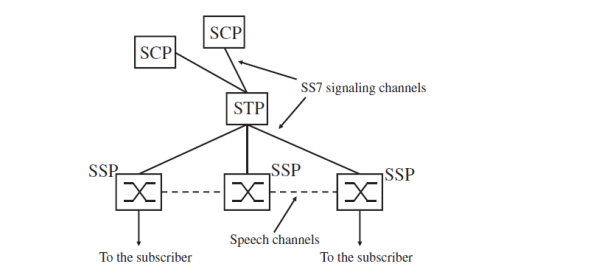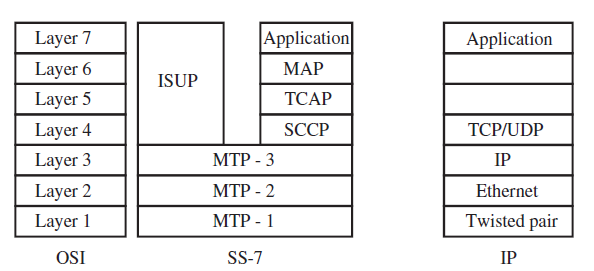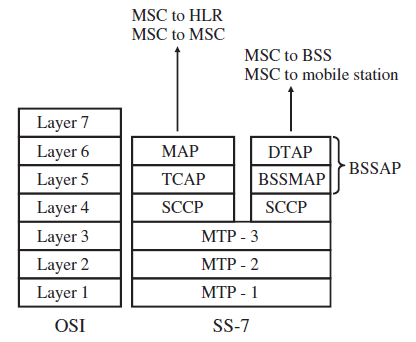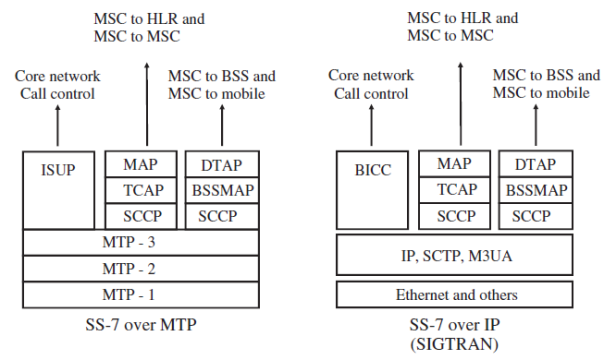- For establishing, maintaining and clearing a connection, signaling information needs to be exchanged between the end user and network devices.
- In the fixed-line network, analog phones signal their connection request when the receiver is lifted off the hook and by dialing a phone number that is sent to the network either via pulses (pulse dialing) or via tone dialing, which is called dual tone multifrequency (DTMF) dialing. With GSM mobile phones, the signaling is done via a separate dedicated signaling channel, and information such as the destination phone number is sent as messages.
- If several components in the network are involved in the call establishment, for example, if originating and terminating parties are not connected to the same switching center, it is also necessary that the different nodes in the network exchange information with each other. This signaling is transparent for the user, and a protocol called the signaling system number 7 (SS-7) is used for this purpose.
The SS-7 standard defines three basic types of network nodes:

- Service Switching Points (SSPs) are switching centers that are more generally referred to as network elements that are able to establish, transport or forward voice and data connections.
- Service Control Points (SCPs) are databases and application software that can influence the establishment of a connection.
- Signaling Transfer Points (STPs) are responsible for the forwarding of signaling messages between SSPs and SCPs as not all network nodes have a dedicated link to all other nodes of the network. STPs only forward signaling messages that are necessary for establishing, maintaining and clearing a call. The calls themselves are directly carried on dedicated links between the SSPs.
The Classic SS-7 Protocol Stack

- The Message Transfer Part 1 (MTP-1) protocol describes the physical properties of the transmission medium on the physical layer ( layer 1 ). Properties that are standardized in MTP-1 are, for example, the definition of the different kinds of cables that can be used to carry the signal, signal levels and transmission speeds.
- On layer 2, the data link layer, messages are framed into packets and a start and stop identification at the beginning and end of each packet is inserted into the data stream so that the receiver is able to detect where a message ends and where a new message begins.
- Layer 3 of the OSI model, which is called the network layer, is responsible for packet routing. To enable network nodes to forward incoming packets to other nodes, each packet gets a source and destination address on this layer. This is done by the MTP-3 protocol of the SS-7 stack. The MTP-3 protocol fulfills the same tasks as the IP protocol. Instead of IP addresses, however, the MTP-3 protocol uses the so-called point codes to identify the source and the destination of a message.
- A number of different protocols are used on layers 4 to 7 depending on the application. If a message needs to be sent for the establishment or clearing of a call, the Integrated Services Digital Network User Part (ISUP) protocol is used. For database access, the Transaction Capability Application Part (TCAP) protocol has been designed as part of the SS-7 family of protocols. TCAP defines a number of different modules and messages that can be used to query all kinds of different databases in a uniform way.
SS-7 Protocols for GSM
Apart from the fixed-line network SS-7 protocols, the following additional protocols were defined to address the special needs of a GSM network.

- The Mobile Application Part (MAP): used for the communication between an MSC and the HLR. It is also used between two MSCs if the subscriber moves into the coverage area of a different MSC while a call is ongoing.
- The Base Station Subsystem Mobile Application Part (BSSMAP): This protocol is used for communication between the MSC and the radio network. Here, the additional protocol is necessary,for example to establish a dedicated radio channel for a new connection to a mobile subscriber. As BSSMAP is not a database query language like the MAP protocol, it is based on SCCP directly instead of using TCAP in between.
- The Direct Transfer Application Part (DTAP): This protocol is used between the user’s mobile device, which is also called mobile station (MS), and the MSC to communicate transparently. To establish a voice call, the MS sends a setup message to the MSC, this message contains among other things the phone number of the called subscriber. As it is only the MSC’s task to forward calls, all network nodes between the MS and the MSC forward the message transparently and thus need not understand the DTAP protocol.
IP-Based SS-7 Protocol Stack
- When using an IP network for the transmission of SS-7 signaling messages, the MTP-1 and MTP-2 protocols are replaced by the IP and the transport medium-dependent lower layer protocols (e.g. Ethernet).

- In the IP stack, layer-4 protocols are either UDP or TCP for most services. For the transmission of SS-7 messages, however, a new protocol has been specified, which is referred to as Stream Control Transmission Protocol (SCTP). When compared to TCP and UDP, it offers advantages when many signaling connections between two network nodes are active at the same time.
- On the next protocol layer, SCTP is followed by the M3UA (MTP-3 User Adaptation Layer) protocol. As the name implies, the protocol is used to transfer information that is contained in the classic MTP-3 protocol. For higher protocol layers such as SCCP, M3UA simulates all functionalities of MTP-3. As a consequence, the use of an IP protocol stack is transparent to all higher layer SS-7 protocols.
- In the industry, the IP-based SS-7 protocol stack or the IP-based transmission of SS-7 messages is often referred to as SIGTRAN (signaling transmission).
- In an IP-based network, voice calls are transmitted in IP packets. As a consequence, the ISUP protocol has to be adapted as well. The resulting protocol is referred to as Bearer-Independent Call Control (BICC) protocol, which largely resembles ISUP.
- As IP links cannot be introduced on all interfaces in live networks at once, Signaling Gateways (SGs) have been defined to bridge E-1 based and IP-based SS-7 communication. The SGs adapt the lower layers of the protocol stack and thus make the differences transparent for both sides. This is necessary, for example, if the subscriber database has already been converted for IP interfaces while other components such as the switching centers are still using traditional signaling links.
- To bridge voice calls between E-1 based and IP-based networks, Media Gateways (MGs) are used. Connected to an MSC Server, an MG handles both IP-based and E-1-based voice calls transparently as it implements both the classic and IP-based signaling protocol stacks.